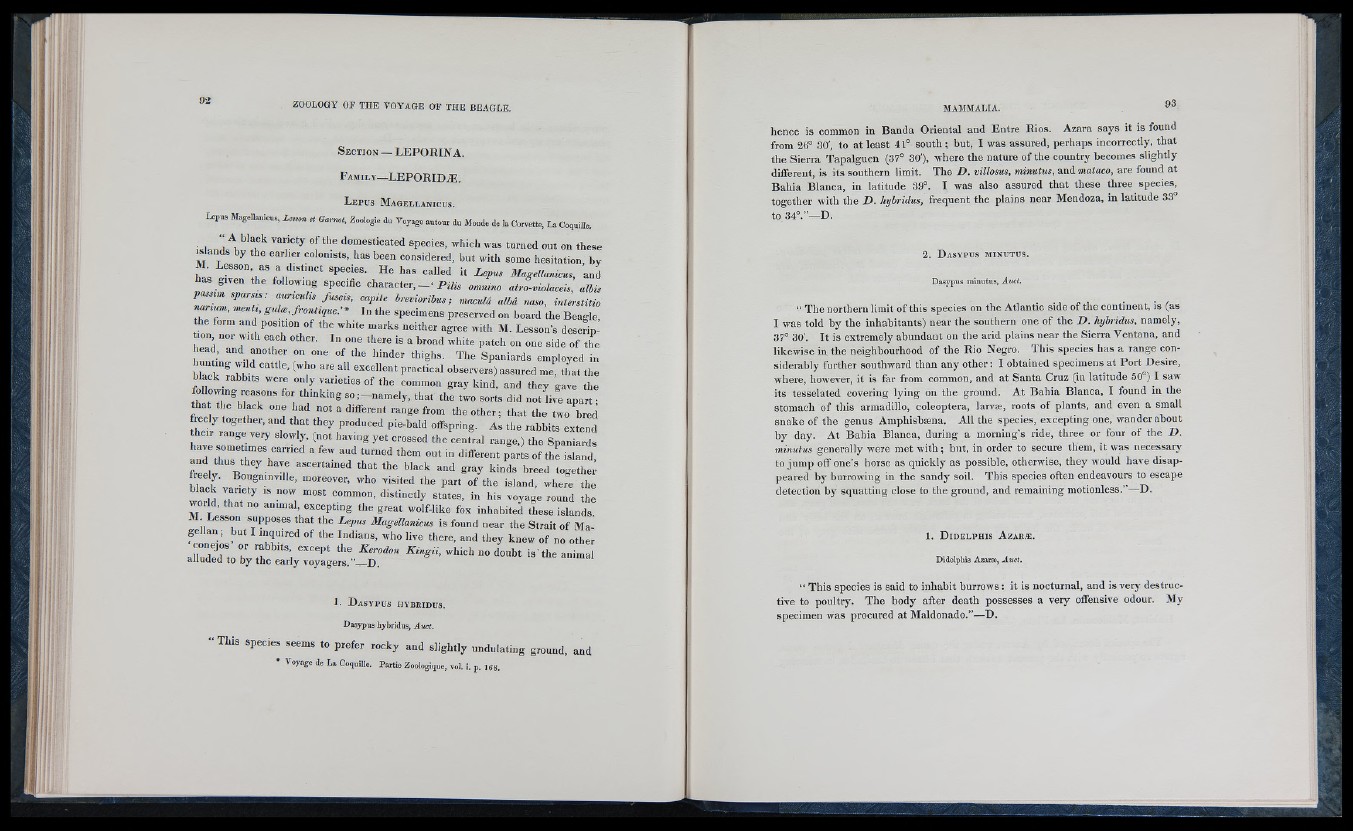
S e c t i o n — LEPORINA.
F a m i l y — LEPORIDÆ.
L e p u s M a g e l l a n ic u s .
Lepus Mugellanicus, i « ™ O am ot, Zoologie du Voyage autour du Moude do k Corvette. La Coquille.
isHnd which was islands by the earlier colonists, has been considered, but with tsuormnee dh eosuitt aotnio nth, ebsye
hhaass given the iollowing specific ch a ra cter,--P ,7/* omnino aMtraog-evliloalnaciceuiss,, aalbnids
pmsim spa,-sis: aur.cuhs fuscis, capite brevioribus; macutâ albâ naso, interstitio
na, I,on, menU g u loe jrantique.'* In the specimens preserved on board the Beagle,
the form and position of the white marks neither agree with M. Lesson’s descripon
nor with each other. In one there is a broad white patch on one side of the
head, and another on one of the hinder thighs. The Spaniards employed in
bbllaacc k“ flaabbbbiht s were on1ly° varieties of the common ogbraseyi -kveinrds), aassnudr etdh emye .g athvaet tthhee
th r r v r r " ' , a'"’'’”® that the two sorts did n o tL e apart ;
f all r h “ t ' ‘>‘*>'='■1 ‘h^t the two bred
thheeiirr rraanTge v’e “ry fs lowly, (not having yet crossed othffes pcreinntgr.a l Arasn tghee.) rtahbeb Sitps aenxitaerndds
fr e V R ^ m ""oottamed that the black and gray kinds breed together
freely. Bougainville, moreover, who visited the part of the island, where the
black vanety is now most common, distinctly states, in his voyage round the
world, that no animal excepting the great wolf-like fox inhabited these islands
M Lesson supposes that the Zepus Magellanicus is found near the Strait of Mage
an, but I inquired of the Indians, who live there, and they knew of no other
1 . D a s y p u s h y b r id u s .
D asypus hybridus, A uct.
■This species seems to prefer rocky and slightly undulating ground, and
Voyage de L a Coquille. Partie Zoologique, vol. i. p. 168.
hence is common in Banda Oriental and Entre Rios. Azara says it is found
from 26° 30', to at least 41° south; but, I was assured, perhaps incorrectly, that
the Sierra Tapalguen (37° 30'), where the nature of the country becomes slightly
different, is its southern limit. The D . viltosus, minutus, and mataco, are found at
Bahia Blanca, in latitude 39°. I was also assured that these three species,
together with the D . hybridus, frequent the plains near Mendoza, in latitude 33“
to 34°.”—D.
2 . D a s y p u s m in u t u s .
Dasypus minutus, Auct.
“ The northern limit of this species on the Atlantic side of the continent, is (as
I was told by the inhabitants) near the southern one of the D . hybridus, namely,
37° 30'. It is extremely abundant on the arid plains near the Sierra Ventana, and
likewise in the neighbourhood of the Rio Negro. This species has a range considerably
further southward than any other: I obtained specimens at Port Desire,
where, however, it is far from common, and at Santa Cruz (in latitude 50°) I saw
its tesselated covering lying on the ground. At Bahia Blanca, I found in the
stomach of this armadillo, coleóptera, larvEe, roots of plants, and even a small
snake of the genus Amphisbtena. All the species, excepting one, wander about
by day. At Bahia Blanca, during a mornings ride, three or four of the D .
minutus generally were met w ith; hut, in order to secure them, it was necessary
to jump off one’s horse as quickly as possible, otherwise, they would have disappeared
by burrowing in the sandy soil. This species often endeavours to escape
detection by squatting close to the ground, and remaining motionless.”—D.
1 . D i d e l p h i s A z a r æ .
Didelpbis Azaræ, Auct.
“ This species is said to inhabit burrows : it is nocturnal, and is very destructive
to poultry. The body after death possesses a very offensive odour. My
specimen was procured at Maldonado.”—D.